Art History 1: Art Identification
5.0(1)
5.0(1)
New
Card Sorting
1/28
Earn XP
Description and Tags
Study Analytics
Name | Mastery | Learn | Test | Matching | Spaced |
|---|
No study sessions yet.
29 Terms
1
New cards
Woman of Willendorf, Austria, 24,000 BCE
* emphasis on woman's female anatomy
* small/ probably meant to be carried or worn
* could have served as fertility image or maybe exchanged between allies as form of nonverbal communication
* maybe created by pregnant woman looking down on own body
* emphasis on woman's female anatomy
* small/ probably meant to be carried or worn
* could have served as fertility image or maybe exchanged between allies as form of nonverbal communication
* maybe created by pregnant woman looking down on own body
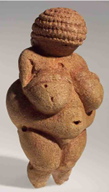
2
New cards
Royal Standard of Ur, Iraq, 2500 BCE
* hierarchy of scale used to depict ruler as more powerful
* several registers
* scene shows a battle/ pictorial narrative of political conflict and war
* hierarchy of scale used to depict ruler as more powerful
* several registers
* scene shows a battle/ pictorial narrative of political conflict and war
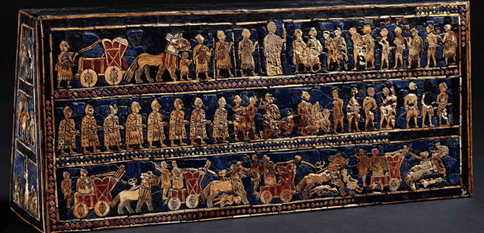
3
New cards
Palette of Narmer, Egypt, 3000 BCE
* likely intended to be temple offering for a god, honors the king who united the 2 parts of Egypt and conveys his power
* dark gray-green stone carved in low relief, there are registers and a circular depression
* hieroglyph writing of the king's name
* hierarchy of scale used as Narmer is striking a kneeling enemy
* likely intended to be temple offering for a god, honors the king who united the 2 parts of Egypt and conveys his power
* dark gray-green stone carved in low relief, there are registers and a circular depression
* hieroglyph writing of the king's name
* hierarchy of scale used as Narmer is striking a kneeling enemy
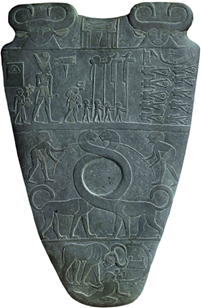
4
New cards
Ishtar Gate, Babylon, 600 BCE
* ceremonial entrance into Babylon
* the yellow, red, brown, etc. colors are low relief representations of mythological animals and deities -- zoomorphic
* this gate played major role in Babylonian religious festival, akitu (procession takes statue of Marduk to small temple, akitu house, outside the city to restore political and social order)
* ceremonial entrance into Babylon
* the yellow, red, brown, etc. colors are low relief representations of mythological animals and deities -- zoomorphic
* this gate played major role in Babylonian religious festival, akitu (procession takes statue of Marduk to small temple, akitu house, outside the city to restore political and social order)
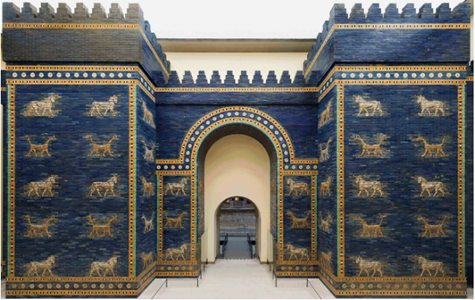
5
New cards
Colossal Statue of Akhenaten, Egypt, Amarna Period, 1300 BCE
* artist: Bak
* depicts Akhenaten wearing his kilt with breasts, full abdomen, narrow waist, and wide hips possibly representing that the king displayed himself as both male and female -- the human version of the androgynous creator Aten
* artist: Bak
* depicts Akhenaten wearing his kilt with breasts, full abdomen, narrow waist, and wide hips possibly representing that the king displayed himself as both male and female -- the human version of the androgynous creator Aten

6
New cards
Last Judgment before Osiris, Book of the Dead, Egypt, 1200 BCE
* painted papyrus
* the book of the dead has images and hieroglyphs and was placed in a tomb to help guide souls in the afterlife
* Osiris is the ruler of the afterlife and judges whether someone has lived an ethical life
* painted papyrus
* the book of the dead has images and hieroglyphs and was placed in a tomb to help guide souls in the afterlife
* Osiris is the ruler of the afterlife and judges whether someone has lived an ethical life
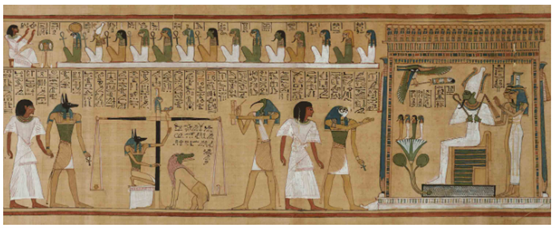
7
New cards
Terra Cotta Army of the First Emperor of Qin, China, 200 BCE
* life size sculptures of soldiers and horses
* the army was intended to serve first emperor of Qin in the afterlife to provide military power, technology, and bureaucracy that helped the Qin state to victory in real life
* life size sculptures of soldiers and horses
* the army was intended to serve first emperor of Qin in the afterlife to provide military power, technology, and bureaucracy that helped the Qin state to victory in real life

8
New cards
Light well in the Palace at Knossos, Crete, 1700 BCE
* light well is small rectangular room open to the sky that lets light and air in
* often build near staircases
* light well is small rectangular room open to the sky that lets light and air in
* often build near staircases
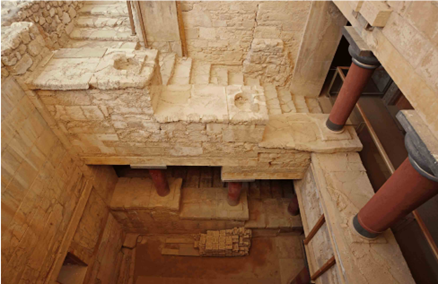
9
New cards
La Venta Throne, Olmec, 900 BCE
* example of rammed-earth architecture (i think) -- carved out of single blocks of stone
* human figure carved in high relief, rest is low relief flower motifs
* the figure is emerging from the underworld
* example of rammed-earth architecture (i think) -- carved out of single blocks of stone
* human figure carved in high relief, rest is low relief flower motifs
* the figure is emerging from the underworld
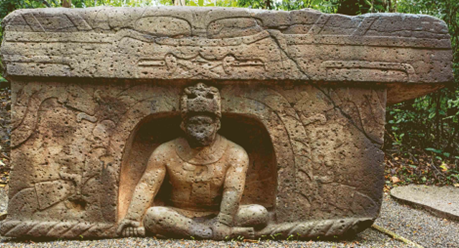
10
New cards
Iktinos and Kallikrates, Parthenon, Athens, 400 BCE
* temple of Athena Parthenos
* the architects are Iktinos and Kallikrates -- they combined balance, proportion, and architectural refinements to create powerful imagery of the democratic ideals and imperial achievements of Athens
* includes large cella and an opisthodomos
* peristyle surrounds the cella and a frieze runs around the exterior of the cella walls
* barely any 90 degree angles since the columns incline inward slightly
* gives viewer impression that building is rising up in a dynamic way rather that appearing static
* temple of Athena Parthenos
* the architects are Iktinos and Kallikrates -- they combined balance, proportion, and architectural refinements to create powerful imagery of the democratic ideals and imperial achievements of Athens
* includes large cella and an opisthodomos
* peristyle surrounds the cella and a frieze runs around the exterior of the cella walls
* barely any 90 degree angles since the columns incline inward slightly
* gives viewer impression that building is rising up in a dynamic way rather that appearing static

11
New cards
Polykleitos, Doryphoros (Spear Bearer), 400 BCE
* Polykleitos is the sculptor (classical age)
* demonstrates more advanced stage of contrapposto
* depicts male warrior (maybe Achilles) and he originally held a spear in his bent left arm
* tilt of his head implies subtle movement
* represents youth naturally with muscles, veins, etc. but is generic and shows the Greek ideals of perfection and beauty
* Polykleitos is the sculptor (classical age)
* demonstrates more advanced stage of contrapposto
* depicts male warrior (maybe Achilles) and he originally held a spear in his bent left arm
* tilt of his head implies subtle movement
* represents youth naturally with muscles, veins, etc. but is generic and shows the Greek ideals of perfection and beauty
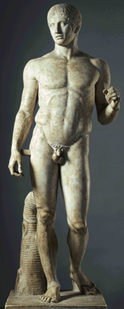
12
New cards
Winged Victory of Samothrace (Nike), Greece, 200 BCE
* artist: Pythokritos
* Hellenistic sculpture
* originally built to be positioned in a niche above the sanctuary at Samothrace so it could be seen
* dramatic, theatrical depiction of winged Nike figure -- dynamic
* an offering to the gods for sanctuary on Samothrace (Greek island)
* artist: Pythokritos
* Hellenistic sculpture
* originally built to be positioned in a niche above the sanctuary at Samothrace so it could be seen
* dramatic, theatrical depiction of winged Nike figure -- dynamic
* an offering to the gods for sanctuary on Samothrace (Greek island)
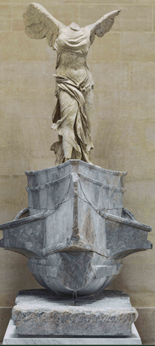
13
New cards
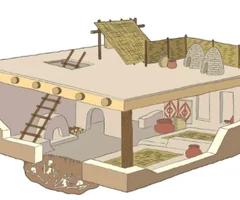
House in Catalhoyuk, Turkey
* a site where humans made transformation from nomad to settler
* made of adobe w/ thick walls
* enter home via doorway on the roof (makes more fortified)
* typically one room and centered around a hearth and often displayed art and decoration
* evidence that the dead were buried under the floors of the home
* made of adobe w/ thick walls
* enter home via doorway on the roof (makes more fortified)
* typically one room and centered around a hearth and often displayed art and decoration
* evidence that the dead were buried under the floors of the home
14
New cards
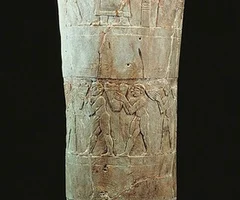
Uruk Vase, Iraq
* low relief pictorial narrative in registers carved in alabaster
* appears to have been broken and reassembled several times -- emphasizing its importance and long life in the temple
* one of earliest examples of pictorial narrative
* lowest register has wavy lines depicting water, topped with an alternating row of plants -- above plants alternating rams and ewes
* 3 level base represents an ordered ecology of water, plants, and animals (most likely associated with worship)
* middle register depicts row of naked men carrying baskets (perhaps visual of ritual offerings of food/drink to gods and goddesses
* top register connects to the others and features a female figure (probably temple priestess) with another figure who is overseeing the ceremony
* appears to have been broken and reassembled several times -- emphasizing its importance and long life in the temple
* one of earliest examples of pictorial narrative
* lowest register has wavy lines depicting water, topped with an alternating row of plants -- above plants alternating rams and ewes
* 3 level base represents an ordered ecology of water, plants, and animals (most likely associated with worship)
* middle register depicts row of naked men carrying baskets (perhaps visual of ritual offerings of food/drink to gods and goddesses
* top register connects to the others and features a female figure (probably temple priestess) with another figure who is overseeing the ceremony
15
New cards
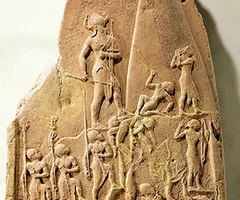
Stele of Naram-Sin, Akkadian
* stele represents break from the visual conventions of previous Mesopotamian monuments since it doesn't have horizontal registers
* the victory narrative is contained in one scene -- framed in mountain landscape
* figure of Naram-Sin is shown in hierarchy of scale carved in low relief and stands victoriously -- facing mountain holding bow and arrow
* honors the king on his military victory and serves as public monument to celebrate king
* the victory narrative is contained in one scene -- framed in mountain landscape
* figure of Naram-Sin is shown in hierarchy of scale carved in low relief and stands victoriously -- facing mountain holding bow and arrow
* honors the king on his military victory and serves as public monument to celebrate king
16
New cards
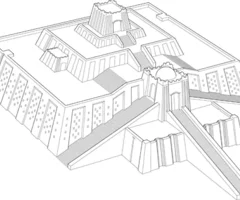
Ziggurat at the Sanctuary of the Moon God Nana, Iraq
* one of the largest ziggurats dedicated to mood goddess Diana
* architectural structure (stepped tower) that was a base for the temples for gods and goddesses that protected the city
* purpose was to allow temple to be closer to heaven so that it could connect heaven and earth and be seen from afar
* architectural structure (stepped tower) that was a base for the temples for gods and goddesses that protected the city
* purpose was to allow temple to be closer to heaven so that it could connect heaven and earth and be seen from afar
17
New cards
Mastaba Tomb, Egypt
* elaborate tombs primarily made for high-ranking male officers in state administration and their family
* decorated with low relief or painted detailed scenes of everyday life -- illustrated crafts, agricultural activities, hunting, animal husbandry, and food preparation
* the deceased would often appear in these scenes (like a visual biography)
* sometimes scenes of loving memories or hopeful images of prosperous afterlife
* blended past, present, and future into single scene
* decorated with low relief or painted detailed scenes of everyday life -- illustrated crafts, agricultural activities, hunting, animal husbandry, and food preparation
* the deceased would often appear in these scenes (like a visual biography)
* sometimes scenes of loving memories or hopeful images of prosperous afterlife
* blended past, present, and future into single scene
18
New cards
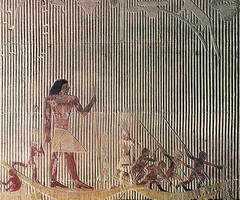
Ti watching a Hippo hunt, Egypt
* the mastaba tomb of Ti
* contained reliefs and paintings intended to nourish his ka and help him do the activities depicted
* his tomb was bigger and more complex than most bc he was a high ranking official in Egypt's fifth dynasty
* in the painted low relief carving it shows Ti overlooking men hunting a hippopotamus
* he is in hierarchy of scale
* contained reliefs and paintings intended to nourish his ka and help him do the activities depicted
* his tomb was bigger and more complex than most bc he was a high ranking official in Egypt's fifth dynasty
* in the painted low relief carving it shows Ti overlooking men hunting a hippopotamus
* he is in hierarchy of scale
19
New cards
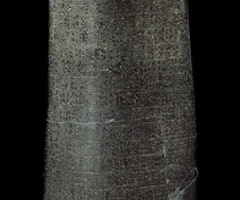
Law Stele of Hammurabi, Babylon
* 7 1/2 foot tall pillar-shaped stele carved out of black basalt
* one of oldest surviving legal records
* top portion was carved in low relief -- face-to-face encounter between Hammurabi and the sun god Shamash (god of justice)
* laws are inscribed in horizontal bands
* image justifies the laws by linking them to divine authority and the archaizing characters of the inscriptions link them to a past golden age
* one of oldest surviving legal records
* top portion was carved in low relief -- face-to-face encounter between Hammurabi and the sun god Shamash (god of justice)
* laws are inscribed in horizontal bands
* image justifies the laws by linking them to divine authority and the archaizing characters of the inscriptions link them to a past golden age
20
New cards
The Apadana, Persepolis
* Persepolis was built as ceremonial city
* a platform leads to the monumental gatehouse that held palaces, a treasury, a throne room, and the Apadana
* the apadana was the largest building and it was an audience hall where the emperor received gifts from dignitaries and representatives from across the empire
* the hypostyle hall held 1000s of people for ceremonies, festivals, etc.
* a platform leads to the monumental gatehouse that held palaces, a treasury, a throne room, and the Apadana
* the apadana was the largest building and it was an audience hall where the emperor received gifts from dignitaries and representatives from across the empire
* the hypostyle hall held 1000s of people for ceremonies, festivals, etc.
21
New cards
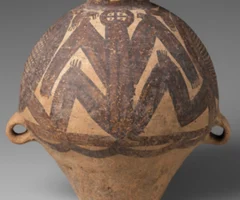
Guan (jar), Majiayao Period
* terra cotta jar painted with pigments
* in upper register there are zoomorphic designs of geometric shapes but the artist used abstract and representational forms
* similar to amphorae which were typical pottery vessels during this time
* in upper register there are zoomorphic designs of geometric shapes but the artist used abstract and representational forms
* similar to amphorae which were typical pottery vessels during this time
22
New cards
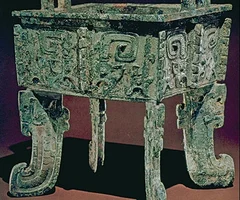
Fang Ding with Taotie Design, Shang Dynasty
* precise meaning of taotie is ongoing -- some say it represents a sacrificial animal or deity in animal form -- others say it is an evolved pattern from the relationship between design and technique in bronze casting
* taotie design is common of a symmetrical animal mask -- spirals and hooks
* use of flat zoomorphic legs
* taotie design is common of a symmetrical animal mask -- spirals and hooks
* use of flat zoomorphic legs
23
New cards
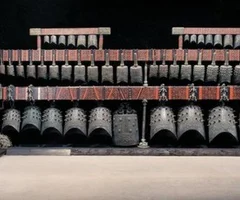
Rack of Bells of marquis Yi, China
* most famous object excavated from tomb of Marquis Yi
* 65 bels strung on wooden rack -- likely required 5 people to play
* found in the central chamber of tomb
* the bells like everything else left in his tomb were to ensure that he had everything necessary to be happy and comfortable in afterlife and prove he was a man of substance
* 65 bels strung on wooden rack -- likely required 5 people to play
* found in the central chamber of tomb
* the bells like everything else left in his tomb were to ensure that he had everything necessary to be happy and comfortable in afterlife and prove he was a man of substance
24
New cards
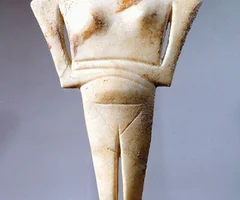
Figure of a Woman, Cycladic
* marble sculpture of human figures carved with flint, obsidian, copper, or done
* naked woman -- arms typically folded over body with only nose as carved facial feature -- suggested that other features were painted
* painted necklaces, bracelets, and diadems
* swollen belly suggests pregnancy
* likely displayed laying down or were carried -- discovered in tombs
* thought to be made for burials or rituals
* naked woman -- arms typically folded over body with only nose as carved facial feature -- suggested that other features were painted
* painted necklaces, bracelets, and diadems
* swollen belly suggests pregnancy
* likely displayed laying down or were carried -- discovered in tombs
* thought to be made for burials or rituals
25
New cards
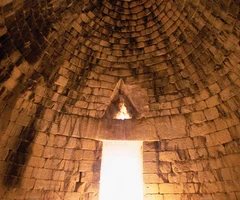
Interior of Treasury of Atreus tholos tomb, Mycenae
\- over 40 ft high corbeling used as a vault system -- stacked stones in horizontal courses until they meet (no mortar used)
26
New cards
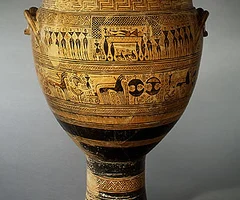
Geometric Krater, Athens
* krater is like a vase and typically help wine mixed with water
* geometric krater was used as a burial marker
* the bottom of the krater is open (possibly to allow liberations to be poured onto the earth)
* most of the surface is decorated with geometric forms
* geometric krater was used as a burial marker
* the bottom of the krater is open (possibly to allow liberations to be poured onto the earth)
* most of the surface is decorated with geometric forms
27
New cards
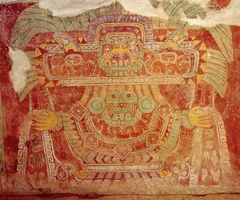
Goddess fresco, Teotihuacan
* refered to as great goddess
* showed frontally with arms outstretch and water seemingly flowing out of hands
* snake around her neck
* elaborate headdress head of a bird also with snake around its neck
* snakes/birds prominent symbol
* overall the imagery is thought to represent the all-encompassing great goddess of Mesoamerica
* showed frontally with arms outstretch and water seemingly flowing out of hands
* snake around her neck
* elaborate headdress head of a bird also with snake around its neck
* snakes/birds prominent symbol
* overall the imagery is thought to represent the all-encompassing great goddess of Mesoamerica
28
New cards
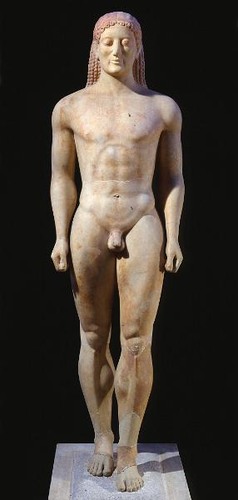
Kouros from Anavysos, Greece
* popularly known as the Anavysos Kouros
* likely to be a heroic nude sculpture set up by family of fallen youth in battle
* same as all kouroi, the young male is naked to reveal sculptors interest in naturalistic and supple forms
* slightly larger than life sized standing rigid with arms down by side, archaic smile is featured (not meant to show joy but to animate the sculpture)
* likely to be a heroic nude sculpture set up by family of fallen youth in battle
* same as all kouroi, the young male is naked to reveal sculptors interest in naturalistic and supple forms
* slightly larger than life sized standing rigid with arms down by side, archaic smile is featured (not meant to show joy but to animate the sculpture)
29
New cards
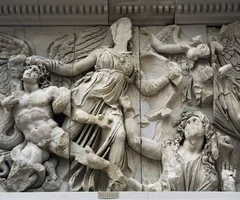
Gigantomachy (Athena battling a giant), Pergamon
* gigantomachy is a legendary battle between gods
* high relief sculpture
* part of the sculpted frieze on Athena's altar
* imagery is presenting real event in mythological way -- metaphor for the defeat of the Gauls
* shows Athena attacking the giants -- she is the winged figure in center
* the earth goddess is pleading with Athena to save her son
* Nike is coming in to crown Athena as victor over the giants
* get sense of horror, pain, defeat -- very dynamic
* high relief sculpture
* part of the sculpted frieze on Athena's altar
* imagery is presenting real event in mythological way -- metaphor for the defeat of the Gauls
* shows Athena attacking the giants -- she is the winged figure in center
* the earth goddess is pleading with Athena to save her son
* Nike is coming in to crown Athena as victor over the giants
* get sense of horror, pain, defeat -- very dynamic